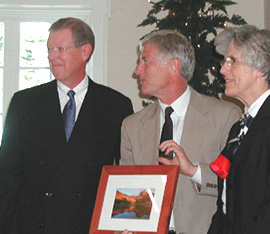Envision Utah Quality Growth Award
Salt Lake City Department of Public Utilities Earns Award of Merit for Water Supply Protection and Water Conservation Programs.
Florence Reynolds
June 3, 2004
|
Planning for the availability of water at a high quality and at the quantity necessary for the community to flourish requires planning. Through the Salt Lake City’s viability has historically been dependent on the limited flow of water from the mountain streams of the Wasatch Canyons. Quality and quantity of water supply has been a hinge pin for the development of the surrounding area. Water law and water rights have been highlighted throughout the history of the city and the state of Utah. The survival of the early pioneers and the subsequent urban growth and development of Salt Lake County have depended on the mountain streams for high quality drinking water in a region of the United States that borders the Great Basin desert. Climactic changes impact both quality and quantity of the water supply, as illustrated by the impacts of the drought conditions that have existed here during the past 5 years.
Water Source Protection
Utah Department of Natural Resources Executive Director Robert L. Morgan recently articulated the importance of protecting our watersheds and the quality of our drinking water, when he described watersheds and lifesheds. During 2003, Salt Lake City Department of Public Utilities pursued two planning programs meant to assure a quality, long term, water supply. The Keep It Pure program was designed to help promote long-term public education on the source of our drinking water and the responsibility of local residents to help maintain water quality. In planning for the future of this growing community, recreational and wilderness opportunities are amenities the community desires, while preserving the quality of the community’s drinking water supply.
Envision Utah projects predict continued population growth along the Wasatch Front, making watershed protection and water supply even more important into the future. Nothing is guaranteed however, without planning and conscious efforts to retain them. This then is the goal of the Keep It Pure campaign, the protection of our watersheds to assure high quality drinking water into the future. Throughout the planning for this program, partnering with the other entities in the canyons; the ski resorts, the Forest Service, the canyon residents and community leaders, has greatly contributed to the acceptance of the concepts.
Water Conservation Programs
Guaranteeing quality doesn’t provide for quantity – for now and in the future. After 5 years of drought it became evident that the seasonal peaking water rate structure, adopted in 1992 for water conservation did not adequately meet the community’s goals during a severe drought. A new rate structure along with a Water Shortage Conservancy Plan was presented to City Council for approval. The Public Utilities Advisory Committee wanted to be proactive in getting information out to the community and the water customers about how to use water more wisely with the idea that if they act early enough in the time of shortage they could forestall serious water restrictions. It was important that Public Utilities be able to deliver water to the community for essential uses. The plan provides for a notification system, tied to the severity of the drought, an educational component, designed to inform residents on how to eliminate non-essential or wasteful uses, and in extreme cases water restrictions and fines for over use.
This water conservation planning process was initiated with the hope that it would never have to be used. It is a plan that provides the City with the opportunity to continue to function despite the lack of normal water supply. It would be available for the Public Utilities to utilize as it sees fit to forestall serious restrictions on indoor water uses. Its applicability to isolated or localized areas of water outages is also important. An area impacted by a broken line, or even an isolated quality problem, would be able to conserve its reduced water supply for critical needs.
Conclusion
Together these programs look forward to the future of Salt Lake City and its water service area in Salt Lake County and address the pressing needs of a safe, and sufficient water supply. One without the other isn’t much good, but together the synergistic combination provides a lifeline to the community. Water, safe and available for essential uses, even in times of limited supply, is a gift to the community made possible through the planning and foresight of professionals willing to address the future by making difficult decisions today
